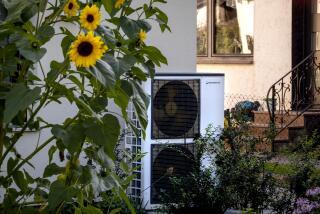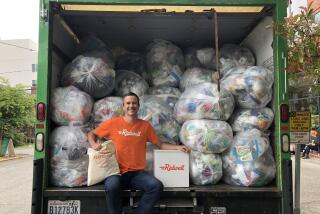Is your clothesline illegal?
When clothes dryers account for at least 6% of the electricity used by U.S. households, is it any wonder that line-drying is coming back? In places where the practice is banned as an unsightly nuisance to neighbors, right-to-dry activists and blogging eco-moms are forming an alliance. Their cause: to reduce energy consumption and to call upon sunlight rather than bleach to get those whites even whiter.
The movement also includes homeowners pinched by rising electric bills as well as some celebrity converts. Yes, there’s even a blog dedicated to tracking who’s who in L.A. line-drying. (For the curious, it’s blog.linedryit.com/eco_facts/, which lists the likes of “The O.C.” actress Rachel Bilson and singer Olivia Newton-John.)
Sophie Uliano, a resident of the Brookside area near Hancock Park, went so far as to hire a specialist to maximize the length of her clothesline in a small backyard dominated by a pool.
“It was one of my chores as a child growing up in Surrey, England,” Uliano said. “I’ll never forget the smell of burying my head in a basket of line-dried laundry. I still do it.”
Uliano, who hangs about 90% of her laundry during the summer and about 60% of it in winter, said no one has complained except for her husband, who always wants it taken down before guests come over.
For her, she said, “The fact that I line-dry my clothes is like a badge of honor.”
::
A 2001 Department of Energy report estimated that electric clothes dryers accounted for about 5.8% of total electricity usage in U.S. homes -- a startling figure given that the same report said all indoor and outdoor lighting in American homes constitutes only 8.8% of electricity usage. Plus, the 5.8% attributed to dryers does not include electricity needed to power the motors of gas-heated dryers.
Still, some people see nothing purposeful or poetic in the image of clean sheets blowing in the wind.
“Homeowner associations recognize that if people throw their clothes over their fences and patio walls that their homes won’t be as aesthetically attractive,” said Richard S. Monson, president of the California Assn. of Homeowners Assns. “We’re criticized for this, but what it’s doing is protecting home values.”
It’s not just the beige-on-approved-beige gated communities that often prohibit line-drying. Homeowner associations at retirement communities, mobile home parks and condos often prohibit the practice. Elleven, Los Angeles’ first condo building to receive the U.S. Green Building Council’s gold LEED rating for environmentally conscious design, has sustainable bamboo flooring -- but line-drying? That’s still strictly verboten, building manager Matthew Davidson said.
Real estate broker Margaret Goedeke lives in Newport Crest, a cluster of beachfront condominiums where open garage doors, flag poles and clothing lines are all prohibited. “We’re not even allowed to hang a towel outside,” Goedeke said. “Once in a while we’ll dry something on our deck, but we hide it. We’re very controlled.”
These kinds of rules drove British film producer Steven Lake to make “Drying for Freedom,” a documentary on line-drying in the U.S. that he said is in pre-production.
“The matter of wasted energy is something that draws my attention to this topic,” he said. “But mostly it’s the fact that in America, which to the rest of the world is considered to be the land of the free, citizens are banned from something as simple and silly as hanging out their washing.”
According to Lake, Southern California will play a particularly large part in the project.
“Not only is that part of the United States full of HOAs, but it is particularly hot, so there is no excuse not to do it,” he said.
If line-drying as a plot line sounds about as scintillating as watching compost decompose, get this: Lake’s film will feature one extreme case. “We’re including feuding neighbors in Mississippi where one man purportedly shot and killed another due to a dispute over a washing line. He didn’t want to see the laundry from his window.”
::
In her 20 years of drying clothes in her Van Nuys backyard, Kathy Arnos is happy to report she has yet to receive a death threat.
“Nobody has ever complained, because it’s completely private,” said Arnos, who is line-less, preferring to hang her clothes from patio chairs and umbrellas. “And even if they could see my clothes, I seriously doubt it would lower my property value.”
Arnos’ boyfriend, David Bower, also avoids the dryer. But instead of using his backyard in Hollywood, Bower hung two lines inside his garage.
“I worried that someone would take my clothes from my backyard,” he said. “And this way, I don’t have to worry about weather conditions.”
In L.A., renters and condo owners even post tips about undercover line-drying on websites such as laundrylist.org.
“Not everyone has a half-acre in the Palisades to dry their clothes,” said Uliano, who is the author of the eco-guidebook “Gorgeously Green.”
“I suggest that people who don’t have a yard do it the Italian way by getting a good old drying rack and placing it near an open window for the day.”
These are tactics that even Monson might agree with.
“We’re not against line-drying,” he said. “Not using dryers can be a good thing, especially in these economical times. We’re asking that residents do so with some discretion.”
Discretion is something Dean Fisher misses. Fisher, a 25-year-old interior designer, likes to line-dry from her Highland Park bungalow apartment. But her neighbor laid claim to a communal brick patio by tying rope between a fence and a tree.
“Oftentimes, I’ll have to fight my way through damp sheets as if I’m trailblazing in the rain forest,” Fisher said. “Or I’ll invite my friends out onto the patio only to be greeted by Dora the Explorer footie pajamas and old-lady bras. Ewww.”
More to Read
Sign up for our L.A. Times Plants newsletter
At the start of each month, get a roundup of upcoming plant-related activities and events in Southern California, along with links to tips and articles you may have missed.
You may occasionally receive promotional content from the Los Angeles Times.






